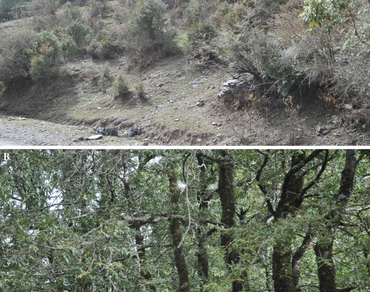Habitat suitability modelling of Buxus wallichiana Bail.: an endemic tree species of Himalaya
Wani Zishan Ahmad, Satish K. V., Islam Tajamul, Dhyani Shalini, Pant Shreekar
Research Articles | Published: 14 July, 2022
First Page: 583
Last Page: 590
Views: 3284
Keywords: Buxus wallichiana , Indian Himalayan region, Anthropogenic threats, Habitat suitability, Conservation
Abstract
Buxus wallichiana, an economically important endemic tree species of Himalaya is facing a serious survival threat from overexploitation and anthropogenic habitat destruction. Habitat suitability was mapped in order to predict the most potential areas for habitat conservation and species reintroduction in Northwestern and western Himalaya using Maximum Entropy Modeling. Habitat suitability modeling predicted Rajouri-Poonch region of Jammu and Kashmir and temperate forests of Uttarakhand as the most suitable habitats for B. wallichiana. Only 0.4% (2765 km2) of the total area of Northwest and Western Himalaya was predicted to be highly suitable for B. wallichiana. The findings of the present study recommend an urgent need to develop a long term conservation and management plan for B. wallichiana, a neglected endemic plant species of Himalaya.

References
Agnihotri P, Husain T, Shirke PA, Sidhu OP, Singh H, Dixit V, Khuroo AA, Amla DV, Nautiyal CS (2017) Climate change-driven shifts in elevation and ecophysiological traits of Himalayan plants during the past century. Curr Sci 112(3):595–601
Ahmad K, Pant S, Rinchen T (2015) Population ecology and regeneration status of Buxus wallichiana (Himalayan Box Tree) in Rajouri-Poonch districts, Jammu and Kashmir, India: Honing Red List of plants. Indian Forester 141(1):29–34
Airi S, Rawal RS, Dhar U, Purohit AN (2000) Assessment of availability and habitat preference of Jatamansi—a critically endangered medicinal plant of west Himalaya. Curr Sci 79(10):1467–1470
Anderson RP (2003) Real vs. artefactual absences in species distributions: tests for Oryzomys albigularis (Rodentia: Muridae) in Venezuela. J Biogeogr 30:591–605
Barik SK, Rao BRP, Haridasan K, Adhikari D, Singh PP, Tiwary R (2018) Classifying threatened species of India using IUCN criteria. Curr Sci 114(3):588–595
Bhatt A, Joshi SK, Gairola S (2005) Dactylorhiza hatagirea (D. Don) Soo-A west Himalayan orchid in peril. Curr Sci 89(4):610–612
Carvalho MC, Gomide LR, dos Santo RM, Scolforo JRS, de Carvalho LMT, de Mello JM (2017) Modeling ecological niche of tree species in Brazilian tropical area. Cerne 23(2):229–240
Chauhan RS (2016) Biotechnological approaches for conservation of rare, endangered and threatened plants. Int J Sci Res Publ 6(12):10–13
Dhyani A, Nautiyal BP, Nautiyal MC (2017) Distribution, status and conservation of Lilium polyphyllum (Liliaceae), a critically endangered medicinal plant from India. Plant Biosystems 154(4):608–611
Dhyani S, Dhyani D (2020) Local socio-economic dynamics shaping forest ecosystems in Central Himalayas. In: Roy N, Roychoudhury S, Nautiyal S, Agarwal S, Baksi S (eds) Socio-economic and eco-biological dimensions in resource use and conservation. Environmental Science and Engineering. Springer. https://doi.org/10.1007/978-3-030-32463-6_3
Frankham R (2003) Genetics and conservation biology. CR Biol 326(1):22–29
Haridassan K, Mao AA, Janarthanam MK, Pandey AK, Barik SK, Srivastava SK, Panda PC, Geetha S, Borthakur SK, Datta BK, Rao BRP (2018) Contributions of plant taxonomy, herbarium and field germplasm bank to conservation of threatened plants: Case study from the Himalayas and Eastern and Western Ghats. Curr Sci 114(3):512–518
Mehta P, Sekar KC, Bhatt D, Tewari A, Bisht K, Upadhyay S, Negi VS, Soragi B (2020) Conservation and prioritization of threatened plants in Indian Himalayan Region. Biodivers Conserv 29:1723–1745
Mir AH, Tyub S, Kamili AN (2020) Ecology, distribution mapping and conservation implications of four critically endangered endemic plants of Kashmir Himalaya. Saudi J Biol Sci 27:2380–2389
Moram C, Tittensor DP, Adl S, Simpson AGB (2011) Worm B. How many species are on the earth and in the ocean. PlosOne Biology 9:1100–1127
Oke OA, Thompson KA (2015) Distribution models for mountain plant species: the value of elevation. Ecol Model 301:72–77
Pant S (2011) Buxus wallichiana L., a multipurpose Himalayan tree in peril. Int J Biodivers Conserv 3(5):175–177
Pascual U, Adams WM, Diaz S, Lele S, Mace GM, Turnhout E (2021) Biodiversity and the challenge of pluralism. Nature Sustainability. https://doi.org/10.1038/s41893-021-00694-7
Phillips SJ, Dudik M (2008) Modeling of species distributions with Maxent: new extensions and a comprehensive evaluation. Ecography 31(2):161–175
Phillips SJ, Anderson RP, Schapire RE (2006) Maximum entropy modeling of species geographic distributions. Ecol Model 190:231–259
Phillips SJ, Dudik M, Schapire RE (2021) [Internet] Maxent software for modeling species niches and distributions (Version 3.4.1). Available from url: http://biodiversityinformatics.amnh.org/open_source/maxent/. Accessed on 08 Apr 2021
Polunin O, Stainton A (1984) Flowers of the Himalaya. Nordic J Bot 5(1)
Puspangadan P, Nair KN (2001) Future of systematics and biodiversity research in India: need for a national consortium and National agenda for systematic biology research. Curr Sci 80(5):631–638
Rands MRW, Adams WM, Bennun L, Butchart SHM, Clements A, Coomes D, Entwistle A, Hodge I, Kapos V, Scharlemann JPW, Sutherland WJ, Vira B (2010) Biodiversity conservation: challenges beyond 2010. Science 329(5997):1298–1303
Samant SS, Dhar U, Rawal RS (1996) Conservation of rare endangered plants: the context of Nanda Devi Biosphere Reserve. In: Ramakrishnan PS, Purohit AN, Saxena KG, Rao KS, Maikhuri RK (eds) Conservation and management of biological resources in Himalaya New Delhi: Oxford and IBH Publishing Company Private Limited, pp 521–545
Sharma S, Arunachalam K, Bhavsar D, Kala R (2018) Modeling habitat suitability of Perilla frutescens with MaxEnt in Uttarakhand-A conservation approach. J Appl Res Med Arom Plants 10:99–105
Singh SP (2007) Himalayan forest and ecosystem services: incorporating in national accounting. Central Himalayan Environment Association, Nainital
Tali BA, Ganie HG, Nawchoo IA, Wani AA, Reshi ZA (2014) Assessment of threat status of selected endemic medicinal plants using IUCN regional guidelines: A case study from Kashmir Himalaya. J Nat Conserv 23:80–89
Tali BA, Khuroo AA, Nawchoo IA, Ganie AH (2018) Prioritizing conservation of medicinal flora in the Himalayan biodiversity hotspot: an integrated ecological and socioeconomic approach. Environ Conserv. https://doi.org/10.1017/S0376892918000425
Viswanath S, Singh RP, Thapliyal RC (2006) Seed bank dynamics of Buxus wallichiana Baillon in a Himalayan moist temperate forest. Trop Ecol 47(1):145–148
Author Information
Conservation Ecology Lab, Department of Botany, Baba Ghulam Shah Badshah University Rajouri, Rajouri, India